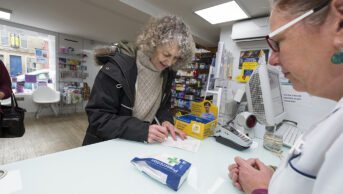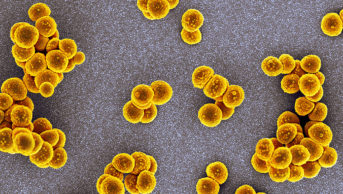
Shutterstock.com
The shocking statistic that 44% of the general population across Europe still does not know that antibiotics are ineffective against the common cold virus brings into sharp focus the enormous challenge that antimicrobial resistance (AMR) presents[1]
.
AMR is one of the biggest threats to modern medicine and the global economy, yet millions of people are unaware of its potentially catastrophic implications.
In his Review on Antimicrobial Resistance published in May 2016, economist Lord Jim O’Neill warned that by 2050 AMR could lead to 10 million deaths a year and a 2–3.5% reduction in gross domestic product (GDP), which would ultimately result in a £100trillion cost to the global economy[2]
. According to the World Bank, unless adequate collective action is taken, the annual costs of AMR could be as large as those of the global financial crisis that started in 2008[3]
.
These stark warnings have led to unprecedented political commitment on a global scale and impressive projects are now underway or being planned. These include consumption surveillance programmes; infection prevention and control initiatives; partnerships with veterinary associations to promote a One Health approach (a concept that recognises that the health of humans, animals and ecosystems are interconnected), and numerous projects to develop antibiotics, vaccines or alternative treatments.
But despite this, up to 50% of all antibiotics currently prescribed globally are unnecessary. Too many patients, unaware of the looming crisis, still feel their illness is somehow validated if they are prescribed an antibiotic, whether they need it or not[4]
. Urgent action is required to fundamentally change this mindset, and time is running out.
In its National Action Plan on AMR, the World Health Organization (WHO) identified five strategic objectives[5]
.
- Improve awareness and understanding;
- Strengthen knowledge through surveillance and research;
- Reduce incidence of infection;
- Optimise use of antimicrobial medicines;
- Ensure sustainable investment for R&D and implementation of control measures.
But without buy-in and support from patients, these objectives will be significantly more difficult to achieve. Community pharmacy can play a vital role.
Much effort is underway across Europe. The European Medicines Agency (EMA) has joined forces with the European Centre for Disease Prevention (ECDC) and the European Food Safety Authority (EFSA) in a bid to make the EU a best practice region in the fight against AMR through research, development and innovation.
The forthcoming annual European Antibiotic Awareness Day (EAAD) on 18 November is an ideal opportunity for pharmacists to plan their strategy[6]
.
The event, coordinated by the ECDC, and supported by the European Commission, the European Parliament, EU member states and non-governmental health stakeholders across the EU, is designed to raise awareness of AMR and help reduce the incidence of infection. There is a plethora of resources available on the EAAD website that pharmacists should make full use of, including campaign materials, posters, infographics and patient stories.
At a recent awareness session hosted by the EMA in London, the UK government was praised as a shining example across the world for the steps it has taken to address the AMR problem.
In its response to the O’Neill review, the government set a target to reduce inappropriate prescribing of antimicrobials by 50% by the year 2020; committed to a reduction in healthcare-associated Gram-negative bloodstream infections in England by 50% before 2020; and pledged to run a regional, highly targeted pilot campaign to determine the most effective way to raise awareness of antimicrobial resistance and drive behaviour change among key audiences[7]
.
Again, pharmacists have a huge part to play in achieving these targets. Public Health England, which is spearheading the drive to reduce AMR in the UK, is encouraging all healthcare professionals to pledge support through its Antibiotic Guardian website[8]
.
Later this year, PHE will launch a public health media campaign to raise awareness of AMR for the first time, which will include a series of films featuring ‘talking antibiotics’.
At this year’s annual conference, the Royal Pharmaceutical Society launched its antimicrobial stewardship (AMS) strategy, which sets out in detail what pharmacists can do at ground level[9]
.
As part of its campaign, the Society produced a quick reference guide on what pharmacists can do, and is calling on all practitioners to familiarise themselves with its contents[10]
.
As the Pharmaceutical Group of the European Union (PGEU) said when it launched a best practice paper in June 2017, the role pharmacists play in “counselling patients and promoting antimicrobial stewardship, providing preventative action, referral, disposal, treatment in the pharmacy and constantly striving for quality improvements and innovation in pharmacy practice” is pivotal[11]
.
The overriding message is that we are ‘all in this together’ and without the efforts and commitment from individuals on the ground, the global battle cannot be won. With this in mind, each and every one of the c. 54,000 pharmacists in Britain should carefully examine what they are currently doing to counter the global threat of AMR.
Then they should look to redouble that effort.
- See the special report on antimicrobial resistance for our most recent news analysis on the importance of diagnostics in tackling AMR , our most recent opinion piece on the importance of measurement in the fight against AMR and our learning piece on antimicrobial therapies for Gram-positive infections.
References
[1] Antimicrobial resistance — summary. April 2016. Available at: https://ec.europa.eu/health/amr/sites/amr/files/eb445_amr_generalsummary_en.pdf (accessed September 2017)
[2] Tackling drug-resistant infections globally: final report and recommendations. The Reviewe on Antimicrobial Resistance chaired by O’Neill J. May 2016. Available at: https://amr-review.org/sites/default/files/160518_Final%20paper_with%20cover.pdf (accessed September 2017)
[3] The World Bank. Drug-resistant infections: a threat to our economic future. April 2017. Available at: http://www.worldbank.org/en/topic/health/publication/drug-resistant-infections-a-threat-to-our-economic-future (accessed September 2017)
[4] Centers for Disease Control and Prevention. About antimicrobial resistance. Available at: https://www.cdc.gov/drugresistance/about.html (accessed September 2017)
[5] World Health Organization. Global action plan on antimicrobial resistance. 2015. Available at: http://www.who.int/antimicrobial-resistance/publications/global-action-plan/en/ (accessed September 2017)
[6] European antibiotics awareness day. A European health initiative. Available at: http://antibiotic.ecdc.europa.eu/en/EAAD/Pages/Home.aspx (accessed September 2017)
[7] Government response to the Reviw on Antimicrobial Resistance. September 2016. Available at: https://www.gov.uk/government/uploads/system/uploads/attachment_data/file/553471/Gov_response_AMR_Review.pdf (accessed September 2017)
[8] Antibiotic Guardian. Available at: http://antibioticguardian.com/ (accessed September 2017)
[9] Royal Pharmaceutical Society. Antimicrobial resistance and stewardship. 2017. Available at: https://www.rpharms.com/making-a-difference/projects-and-campaigns/antimicrobial-resistance-stewardship (accessed September 2017)
[10] Royal Pharmaceutical Society. Antimicrobial stewardship (AMS): quick reference guide. Available at: https://www.rpharms.com/resources/quick-reference-guides/antimicrobial-stewardship-ams-qrg (accessed September 2017)
[11] Pharmaceutical Group of the European Union — best practice paper on AMR. June 2017. Available at: http://www.pgeu.eu/en/press/242:pr-pgeu-releases-best-practice-paper-on-amr.html (accessed September 2017)


